PROFILES IN EXCELLENCE
The 2019 Inductees to the National Gallery for America's Young Inventors are bright young scientists who are changing our world!
Check out these brilliant inventors!
NADIA ANSARI, Gr 10 - "SYSTEMS AND METHODS FOR PROVIDING COLD LASER THERAPY TO A PATIENT IN A HANDS-FREE MANNER"
For the past three years I have suffered from chronic pain and neuropathy, and I wanted to create an attachment for a photobiomodulation device that I have used. With the patented attachment, patients are able to receive therapy for extended periods of time, and won't have to worry about the device overheating, skin sensitivity, or getting help from another individual. I hope that the invention can help millions of people who suffer from neuropathy.
AUDREY BAKERSON, Gr 12 - "NON-INTRUSIVE ANTIGEN / ANTIBODY ALLERGY TEST"
My non-intrusive allergy test invention detects antigen/antibody reactions and has the potential to positively impact millions of allergy sufferers and prevent millions of them from being hospitalized each year. Being non-invasive not only takes out the risks associated with the current skin prick and blood tests, but it is also cost-effective and feasible with patients providing saliva or urine to be tested. Currently, the test is completed in a laboratory and detects dog/cat reactions, but I foresee this test not only expanding to test a multitude of allergens but also being as readily available as over-the-counter pregnancy tests.
NEEL JAIN, Gr 11 & POOJA JAIN, College Freshman (TEAM) - "SKYHOUND: A LOW-COST 3D PRINTED AUTONOMOUS WIFI TRACKING SEARCH DRONE TO LOCATE MISSING VICTIMS OF NATURAL DISASTERS"
SkyHound is a multi-use take on a global issue that innovates the way in which we utilize modern search and rescue techniques and procedures. By mounting a WiFi tracker and a GPS receiver onto our drone, WiFi signals emanating from missing victims' smartphones can be quickly mapped in a given area and relayed to search and rescue personnel who can then use this information to help focus their relief efforts. From this, we developed a system to track potential survivors / victims of natural disasters as fast and efficiently as possible. To begin our project, we divided our invention into two separate components: the Sky portion of the project is a fully-automated 3D printed and scratch-built drone capable of flying without remote control guidance; and the Hound portion is a system using Wireshark (an open source program) to sniff phone signals from as much as 200 meters away. We developed our design with the intention of making it low-cost, effective, and as accessible as possible. Because we wanted our invention to be universal, we were mindful to keep the cost relatively low so that areas in all parts of the world could employ numerous SkyHound systems in the event of the next major natural disaster (at any given time). That being said, our project totaled to be roughly $250, as opposed to the modern technology ranking at about $5,000 to $10,000.
MELANIE QUAN, Gr 11 - "PLASTALGIX: DEVELOPING A SUSTAINABLE CYCLE OF COMPOSTABLE AND WATER-SOLUBLE PLASTICS USING WASTE PRODUCTS OF ALGAE-BASED BIOFUELS"
Plastic pollution has become a global environmental crisis, with nearly 40% of waterways covered in floating plastic waste. In order to combat this growing problem of plastic pollution, this experiment sought to develop an alternative plastic material. Using the waste products of algae-based biofuel production, I created plastics that are compostable in soil, water soluble, serve as natural fertilizers, and exhibit similar physical properties to conventional petroleum-based plastics used widely today. Research included finding an optimal algae species, testing strength, and evaluating potential environmental impacts in various routes of disposal. The implications of this new material are significant as they show that algal bioplastics have tremendous potential as sustainable solutions to the global plastic pollution crisis.
ESHIKA SAXENA, College Freshman - "HEMACAM: A MOBILE PHONE MICROSCOPY SYSTEM FOR AUTOMATED SCREENING OF HEMATOLOGICAL DISEASES USING COMPUTER VISION TECHNIQUES AND CONVOLUTIONAL NEURAL NETWORKS"
Hematological diseases affect millions of people worldwide. Early diagnosis is key to treating/mitigating these diseases, but diagnosis is costly, time-intensive, and requires trained medical professionals. Automated or in-home screening can greatly improve the prognosis and treatment of these diseases. My research focused on developing a low-cost, smartphone-based, solution that instantly screens for hematological diseases. I successfully designed a clip-on smartphone microscope attachment that captures blood cell images from a blood-smear. I applied computer vision techniques to segment the individual cells and trained deep-learning models to automatically classify blood cell morphology, detect abnormalities, and screen for diseases.
ASHAY SHAH & ASHNA SHAH, College Freshman (TEAM) - "OPTIMIZING ELECTRODE PORES UTILIZING THE IMMISCIBLE POLYMER BLEND PAN-PS FOR LOW-COST, HIGH ENERGY DENSITY, WIDE TEMPERATURE RANGE SUPERCAPACITORS"
Supercapacitors are energy devices with applications in the medical and automobile industries. One problem is their lower energy density compared to batteries. We developed a low-cost, high energy-density supercapacitor with a wide operating temperature window. We created four supercapacitors using Polyacrylonitrile-Polystyrene blends. The supercapacitors exhibited energy densities 15x greater than commercial supercapacitors due to the first-ever formation of electrode channels. Our supercapacitor charged fully in 20 seconds, meaning it could charge cellphones in seconds. Our supercapacitor was 3x cheaper than commercial supercapacitors and remained efficient throughout -50°C - 110°C. The supercapacitor demonstrated 40-49.5% higher fuel economies than vehicles with lithium-ion batteries.













